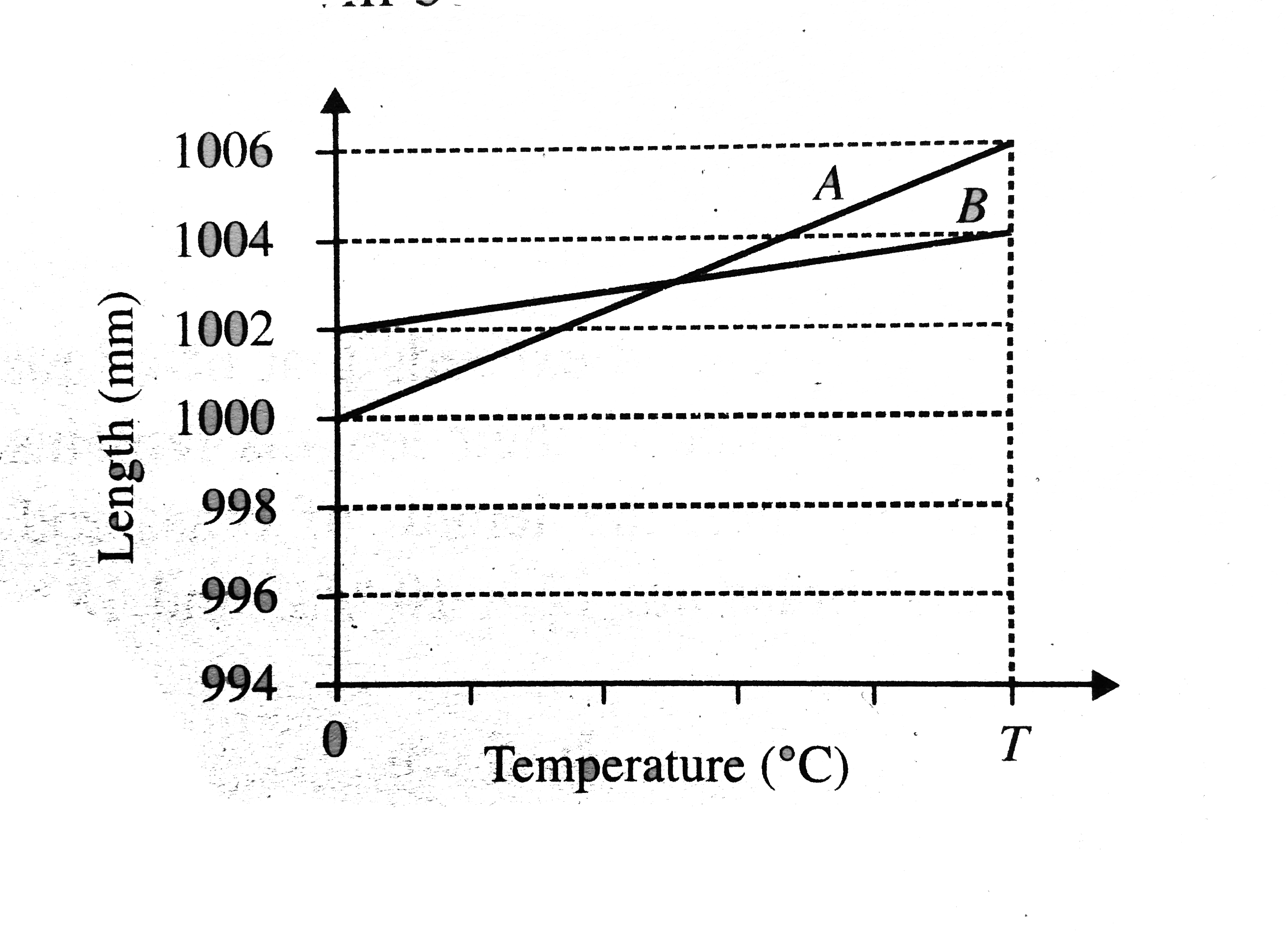At 0∘C, three rods of equal length form an equilateral triangle. Among the three rods, one is made of invar (with neligible expansion) and the other two rods are made of some other metal. When the triangle is heated up to 100∘C, the angle between the two rods of the same metal changes to (π3−θ). Show that the coefficient of linear expansion of the metal is √3θ200∘C−1.
Suppose at 0∘C the lengths of the rods are l and the coefficient of linear expansion of the metal of AD and BD is α. The inner rod AB has no expansion.
If l1 is the length of each of the metal rods AD and BD at 100∘C,l1=l(1+100α).
A perpendicular DO is drawn from the vertex D on AB [Fig. 5.7].
From the trianlge ADO, we get,
l2sin(π6−θ2)=l1sin90∘
or, l2sin(π6−θ2)=l(1+100α)1
or, sin(π6−θ2)=12(1+100α)
or, sinπ6cosθ2−cosπ6sinθ2=12(1+100α)
or, 12−√32⋅θ2=12(1+100α)
[Since θ is very small, sinθ2→θ2 and cosθ2→1]
or, √32⋅θ2=12−12(1+100α)=100α2(1+100α)
or, √3θ2=100α1+100α=100α
[As 100α is very small compared to 1, it is negligible]
or, α=√3θ200∘C−1.

Topper's Solved these Questions
- EXPANSION OF SOLIDS AND LIQUIDSBOOK - CHHAYA PUBLICATIONCHAPTER - EXPANSION OF SOLIDS AND LIQUIDSEXERCISE - SECTION RELATED QUESTIONS
6 Videos
- EXPANSION OF SOLIDS AND LIQUIDSBOOK - CHHAYA PUBLICATIONCHAPTER - EXPANSION OF SOLIDS AND LIQUIDSEXERCISE - HIGHGER ORDER THINKING SKILL (HOTS) QUESTIONS
31 Videos
- EXPANSION OF GASESBOOK - CHHAYA PUBLICATIONCHAPTER - EXPANSION OF GASESEXERCISE - CBSE Scanner
1 Videos
- FIRST AND SECOND LAW OF THERMODYNAMICSBOOK - CHHAYA PUBLICATIONCHAPTER - FIRST AND SECOND LAW OF THERMODYNAMICSEXERCISE - CBSE SCANNER
18 Videos
Similar Questions
When a metal rod is heated through 30∘C the thermal strain in the rod is 3.6×10−4 .what is the coefficient of linear expansion of the metal ?
View SolutionOn heating the metal rod of length 2m from 0°C to 50°C, its length is increased by 0.1 cm. the coeffecient of linear expansion of metal rod is
View Solution
Knowledge Check
On heating the metal rod of length 2m from 0°C to 50°C, its length is increased by 0.1 cm. the coeffecient of linear expansion of metal rod is
A2⋅10−4°C−1B10−4°C−1C1⋅10−5°C−1D2⋅10−5°C−1The coefficient of linear expansion of a metal rod is 12×10−6/0C, its value in per ^(0)F
A203×10−6/0FB154×10−6/0FC21.6×10−6/0FD12×10−6/0F
The variation of length of two metal rods A and B with change in temperature is shown in Fig. the coefficient of linear expansion αA for the metal A and the temperature T will beAαA=3×10−6/∘C,500∘CBαA=3×10−6/∘C,222.22∘CCαA=27×10−6/∘C,500∘CDαA=27×10−6/∘C,222.22∘C

The variation of length of two metal rods A and B with change in temperature is shown in Fig. the coefficient of linear expansion αA for the metal A and the temperature T will be
View SolutionA metal rod measures 50 cm in length at 20∘C. When it is heated to 95∘C, the length becomes 50.06cm. What is the coefficient of linear expansion of rod ? What will be the length of the rod at −20∘C?
View SolutionA copper rod of length l0 at 0∘C is placed on smooth surface. Now, the rod is heated upto 100∘C. Find the longtidudinal strain developed.
(α=coefficient of linear expansion)
View Solution
The variation of length of two metal rods A and B with change in temperature is shown in Fig. the coefficient of linear expansion αA for the metal A and the temperature T will be? ( alpha_(A)=3x10^(-6)/ C )
View SolutionThe length of a metallic rod is 5 m at 0∘C and becomes 5.01m , on heating upto 100∘C . The linear expansion of the metal will be
View Solution
